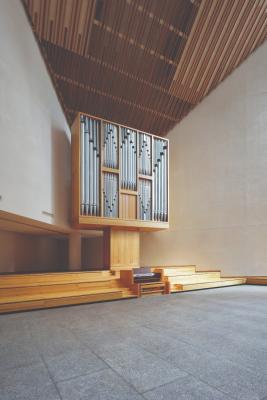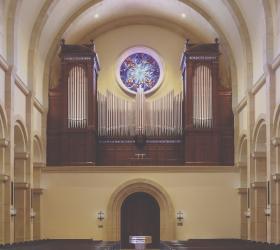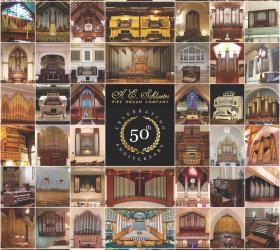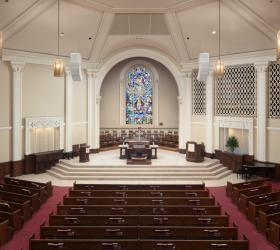
In Midtown Manhattan, at the corner of Lexington Avenue and 54th Street, stands a comparatively humble yet eye-catching edifice. Dwarfed by the iconic tower soaring overhead, Saint Peter’s Church appears grounded and approachable. From street level, the sanctuary, clad in Caledonia granite, rises to sixty feet, but the sanctuary floor lies twenty-five feet below, making for an impressive interior height of eighty-five feet. A skylight bisects the building diagonally from southwest to northeast, providing dynamic natural light and giving passersby the opportunity to see into the sanctuary. Completed in 1977, both church and skyscraper were conceived by architects Hugh Stubbins and W. Easley Hamner as a single redevelopment project, Citicorp Center.
Saint Peter’s interior, designed by Lella and Massimo Vignelli, is said to be one of the finest examples of late mid-century modernism. For the Vignellis, it was important that the space be flexible in order to serve the established purposes of Lutheran liturgy and much more. Their vision allows the sanctuary to serve as a house of worship as naturally as a place for concerts, lectures, performances, meetings, and community gatherings. Johannes Klais Orgelbau in Bonn, Germany, was commissioned to build a two-manual, 32-stop mechanical-action organ for the new sanctuary. Klais worked in tandem with the Vignellis on the case and console designs, resulting in an organ uniquely integrated into its architectural setting.
On January 4, 2021, Saint Peter’s suffered a severe trauma in the form of flood damage from the rupture of a municipal water main. Hundreds of thousands of gallons of water surged into the building, causing major damage to the below-ground sanctuary and the basement-level black box theater, community spaces, and administrative offices underneath. A layer of fine muddy silt covered every surface. Mitigation efforts, including rapid dehumidification to prevent a mold outbreak, stressed all wooden furnishings, in particular the pipe organ.
Pastor Jared R. Stahler and Cantor Bálint Karosi received expert guidance with regard to their predicament, and on January 26, twenty-two days after the flood, a crew from the Organ Clearing House arrived to begin dismantling and packing the Klais for shipping. On February 5, the organ parts arrived at the Gloucester workshop of C. B. Fisk, Inc., for evaluation and, eventually, reassembly. The initial plan called for a thorough restoration of the instrument, and a strategy was developed to accomplish that. But after the organ had been standing in the Fisk erecting room for some months, giving all parties opportunity to inspect and fully grasp the organ’s condition, creative minds got to pondering. A gradual evolution in the collective mindset followed—from that of simple restoration to one of reimagination.
At its installation in 1977, the Klais instrument was an important addition to the emergent mechanical-action organ scene in the United States. A mere sixteen years had passed since the 1961 debut of Charles Fisk’s landmark tracker at Mount Calvary Church in Baltimore. Historically informed musical instrument building and attention to early performance practice were leading edge. Now, nearly a half-century later, the tracker movement has matured; instrument builders are more and more conscious of ways to be inclusive of multiple traditions without sacrificing the central attributes of the historically informed philosophy. The Saint Peter’s flood, though unexpected and deeply disruptive, offered a compelling opportunity for artistic renascence of the Klais.
Keen to authentically perform the sacred music of Johann Sebastian Bach and his contemporaries in a worship setting, Dr. Karosi founded the Bach Collegium at Saint Peter’s in 2017. As a professional vocal and instrumental ensemble, it offers worshippers faithful re-creations of eighteenth-century Lutheran church music. Bach spent his professional career in the central German region of Thuringia, which, together with neighboring Saxony, were home to some exceptional organbuilding in the eighteenth century. Dr. Karosi, who knows these organs well, proposed adding some authentic Thuringian voices to the Klais, and he put forth a detailed plan. To accomplish his objectives, selected stops would need to be repurposed, others relocated, and a few removed. At the Fisk workshop, studies were made to determine what would be feasible in terms of windchest modifications, and pipe scaling practices of the eighteenth-century central German builders were examined in detail.
Acoustician Dana Kirkegaard advised on acoustical matters, including updates to the sanctuary’s amplification and recording systems. Preservation architect Angela Wolf Scott joined the team to guide all aspects of the sanctuary restoration, ensuring that the Vignellis’ original designs would be respected in every detail, including all visual aspects of the organ console, bench, and case. Given the integrated design of every element of the sanctuary, a new audio-visual control board as well as speaker cabinets made to look like the originals but containing state-of-the-art interior components and electronics were constructed at the Fisk shop of wood and finish to match the organ.
By June 2022, a revamped organ stoplist had been generated. Three entirely new 8′ registers—Principal, Grossgedackt, and Quintadehn—all in eighteenth-century Thuringian style, were added to the Great division. The Klais façade 8′ Principal was retained and renamed 8′ Prestant. The original Great 8′ Rohrgedackt was moved to the Pedal and rechristened 8′ Gedackt. A new 8′ Rohrflöte, scaled and voiced in nineteenth-century style, replaced the original 8′ Gedackt in the Swell. The two 4′ flutes traded places, with the Rohrflöte relocating to the Great and the wooden Traversflöte moving to the Swell. The latter, in order to fit on the Swell chest, received new metal pipes from CC–F0. Other space-management revisions included saying farewell to the Great 11⁄3′ Larigot and the Swell 2′ Principal. In the Pedal, the wooden 16′ Subbass received a new CC pipe, increasing its scale by one note, and higher cut-ups.
Due to the fact that the Klais 8′ and 4′ principals had been previously revoiced (work that included raising the wind pressure in the Great from 2.75 inches to 3.35 inches, and raising cut-ups), overarching decisions with regard to pitch and wind pressures were necessary. Having had the opportunity to hear the Klais in situ before the flood, our remembered impressions, together with Dr. Karosi’s input, guided our decision making. With regard to wind pressures, the Great was left as we found it, the Swell was increased from 2.55 inches to 3 inches, and the upper Pedal chest pressure was raised from 2.95 inches to 3.35 inches to match that of the lower Pedal. The temperament was changed from equal to Kellner. The pitch of the organ as we received it was curiously high, with pipes on the voicing jack registering between A 446–447. In order to lower it to something within reason, we were obliged to fit slide tuners to all cone-tuned flue pipes. Reed remedies were more complicated.
In contrast to the tonal breadth of the renamed 8′ Prestant, the new Thuringian Principal, of high tin content and with delicate nicking, offers an array of concentrated overtones, suitably prompt speech, and a pleasing textural quality. The Grossgedackt, constructed of hammered lead, exhibits purity, roundness, transparency, and calm. The Quintadehn, a fine example of the colorful Thuringian models, is replete with subtle harmonics, articulate speech, and an attractive buoyancy. Together, these recreated antique voices show an ability to blend with ease in various combinations. What’s more, while offering the listener a fascinating window into the organ soundscape familiar to J. S. Bach, these stops integrate well within the instrument’s overall tonal design. Without question, they enhance the organ’s potential for musical expression.
With the reeds, there were three intertwining factors to be addressed: wind pressure, pitch, and tongue curvature. The Great 8′ Trompete was given new heavier tongues throughout; from CC–B0 resonator slots were soldered shut; and from c1 up resonators were lengthened. The Swell 16′ Dulcian (small scale wood) required a new longer C0 resonator and the moving up of resonators by one note from that point. The Pedal 8′ Holztrompete (conical wood) needed a new longer CC resonator and the bumping up of the remainder by one note. The Swell 8′ Cromorne was the beneficiary of extra-long slide tuners and tongue weighting. The Pedal 4′ Schalmey, a stop with a troubled history, was replaced with a mid-1970s era Fisk Cremona at 8′ pitch. All tongue curvatures were revised to accommodate the higher wind pressures; the utterly transformative nature of this tongue work cannot be overstated. The once excessively bright Great Trompete became rounder and more foundational thanks to its heavier tongues and proper curvature. The Swell Dulcian filled out and became milder, and, though still endowed with a measure of characteristic quirkiness, is now an effective underpinning for a 16′ chorus registration. The Cromorne, once bold and sassy, now speaks as a controlled yet charming clarinet, offering versatility as both a solo and chorus register. The Pedal Posaune and Holztrompete, the only reeds on their original pressure, with tongue refinements took on more of an old-style Germanic character. The “new” Pedal Cremona is an effective 8′ solo stop, very useful for cantus firmi in the feet.
Substantial upgrades were made to the organ’s key action. The ravages of time and of the flooding/drying cycle had taken their toll. Also, there was a desire to bring the key action up to modern Fisk standards of performance, reliability, and serviceability. The original Klais wooden trackers, which had become brittle and warped, were replaced with impervious carbon fiber trackers. The manual rollerboards were rebuilt using current standard Fisk materials, including replacement of the worn felt-bushed bearings with precise, self-lubricating UHMW (Ultra-High Molecular Weight) polyethylene bearings. The coupler mechanisms were removed from inside the console, where they were nearly impossible to service and maintain. A newly designed CNC-machined aluminum coupler stack was built and placed inside the base of the organ. In this new location, the couplers are more direct, stable, and efficient, plus they are much easier to adjust and maintain. The keyboards were replaced—with motion ratios engineered to complement the new coupler mechanism—and a new Fisk pedalboard was built.
The Saint Peter’s organ stands as a shining example of how a deeply considered, disciplined, and sympathetic approach to restoration can yield a musical instrument of the highest artistic integrity. In this particular case, an opportunity resulting from truly unfortunate circumstances gave rise to a transformational effort on the part of the organbuilders at C. B. Fisk. We are grateful to Pastor Stahler and Dr. Karosi for approaching us to do this work. And finally, to the parishioners of Saint Peter’s and to the greater New York City audiences, we wish you “good listening.”
—David Pike,
Executive Vice President, C. B. Fisk
A note of gratitude from Saint Peter’s Church
With the entire Saint Peter’s community, we are immensely thankful for all who responded in the wake of the January 4, 2021, flood, particularly C. B. Fisk, Inc. Extraordinary skill, dedication, and sensitivity helped us turn an unexpected tragedy into an opportunity most congregations spend years planning.
David Pike’s thoughtful collaboration with Bálint Karosi on the instrument’s tonal reimagination brought a level of creativity—two 8′ principals on a medium-sized instrument!—few builders would even consider. Nami Hamada’s voicing of new and old flue pipes is extraordinary. Michael Kraft and Carl Klein magically transformed Klais’s neo-Baroque reeds. The entire team worked tirelessly: from installing new piston arrangements and Bluetooth page-turning capability, to replacing electronic couplers with mechanical couplers, to addressing fissures on windchests, to constructing a new windline for the Great—all while preserving the architectural details of the instrument so deeply integral to Saint Peter’s iconic sanctuary.
We are also thankful to the performers, participants, sponsors, and donors committed to our ongoing inauguration. The events of November 4–5, 2023, included Guy Bovet’s Peep the Piper, an organ half-marathon featuring four celebrated young organists (Amelie Held, Mi Zhou, Daniel Jacky, and Jonghee Yoon), a masterful solo recital by Nathan Laube, Nicole Keller’s inspired playing of three organ concerti—including a new organ concerto by Bálint Karosi, In Memoriam György Ligeti—with Saint Peter’s Chamber Orchestra, and a presentation of Maurice Duruflé’s Requiem featuring Colin Fowler and Saint Peter’s Choir and Chamber Ensemble. February 13, 2024, features Felix Hell in what is very much a homecoming performance, and on June 4, 2024, Cantor Karosi plays a solo recital. These programs aim to showcase the tonal changes carried out by C. B. Fisk, both individually and as a whole, as well as the instrument’s versatility in a variety of contexts and pairings, including as one of the only remaining places in New York City where organ and orchestra can perform in a concert hall setting.
To learn more about the instrument and celebratory events, visit
future.saintpeters.org/organ.
—Pastor Jared R. Stahler and
Cantor Bálint Karosi
Builder’s website: cbfisk.com
Church website: saintpeters.org
Cover photo: Marco Anelli
GREAT (manual I)
16′ Pommer 58 pipes
8′ Prestant 58 pipes
8′ Principal*** 58 pipes
8′ Grossgedackt*** 58 pipes
8′ Quintadehn*** 58 pipes
4′ Octave 58 pipes
4 Rohrflöte† 58 pipes
2-2⁄3′ Quinte 58 pipes
2′ Superoctave 58 pipes
1-3⁄5′ Terz 58 pipes
1-1⁄3′ Mixtur V 290 pipes
8′ Trompete** 58 pipes
Tremulant
SWELL (manual II)
8′ Gamba 58 pipes
8′ Schwebung (G# on) 50 pipes
8′ Rohrflöte* 58 pipes
4′ Principal 58 pipes
4′ Traversflöte*‡ 58 pipes
2′ Waldflöte 58 pipes
2-2⁄3′ Cornet II‡ 116 pipes
1′ Scharff IV 232 pipes
16′ Dulcian 58 pipes
8′ Cromorne 58 pipes
Tremulant
PEDAL
16′ Principal 32 pipes
16′ Subbass 32 pipes
8′ Octave 32 pipes
8′ Gedackt 32 pipes
4′ Superoctave 32 pipes
2-2⁄3′ Hintersatz IV 128 pipes
16′ Posaune 32 pipes
8′ Holztrompete** 32 pipes
8′ Cremona§ 32 pipes
MECHANICALS & ACCESSORIES
300 levels Solid State Organ Systems***
Mechanical balanced Swell Pedal
by thumb and toe
Sw/Gt, Gt/Ped, Sw/Ped
Generals 1–12
Divisionals 1–6
Sequencer Next***
Sequencer Prev***
Page turning reversible pistons with Bluetooth capability ***
by toe
Cymbelstern: 8 tuned brass bells in memory of Katherine and Harry Busch
Birdsong: reservoir and 7 pipes
2023
Console and keyboards
Carbon-fiber action
Kellner Temperament A=440
Wind (in mm) raised to 85/Gt, 75/Sw, 85/Ped
*** new
** new tongues
* bottom new
† previously on Swell
‡ previously on Great
§ from Fisk Opus 68




